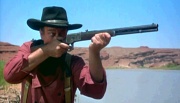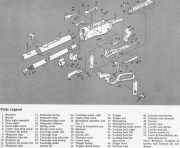Difference between revisions of "Winchester Model 1892"
(→Resources) |
m (1 revision) |
Latest revision as of 16:58, 15 March 2013
| |||||||||||||||||||||||||||||||||||||
The Winchester Model 1892 is a lever-action repeating rifle designed by John Browning as a smaller, lighter version of his large-frame Model 1886, and which replaced the Model 1873 as the company's lever-action for smaller dual-use rounds such as the .44-40 (.44 WCF).[1] Calibers for the rifle vary and some are custom-chambered. The original rounds were the .32-20, .38-40, and .44-40 Winchester center fire rounds, followed in 1895 by the new .25-20. A few Model 92's chambered for .218 Bee were produced in 1936-38.
The Winchester Models 53 (1924) and 65 (1933) were essentially relabelled Model 1892's.
Contents[hide] |
[edit] History
The success of the Winchester Model 1873 proved that having a rifle capable of sharing cartridges with handguns was a popular feature for consumers. In the mid-1880s, hoping to cash in on the trend, Winchester Repeating Arms began looking for a new lever-action rifle that could withstand higher pressures found in contemporary military cartridges used for single-shot rifles, at the behest of then-company president Thomas G. Bennett (Oliver Winchester’s son-in-law).
John M. Browning provided the solution — in one of his earliest firearms developed for Winchester (the Model 1886), Browning designed the first repeating rifle to incorporate dual sliding vertical breech locks. This strong design feature was carried over to the 1892, in addition to the massive frame and parts, and proved able to easily handle the pressures of the .45-70 Gov’t, .45-90 Win. and .50-110 Win., among many others. Its light weight and compact, smooth lever-action design have made the ’92 considered one of the finest Winchester rifles of the 19th century.
1,004,675 Model 1892 rifles were made by Winchester, and although the company phased them out by 1941, they are still being made today under the Puma label by the Brazilian arms maker, Rossi, and by Chiappa Firearms, an Italian factory and Browning in Japan. In its modern form, using updated materials and production techniques, the Model 1892's action is strong enough to chamber even the highest pressure handgun rounds, such as .357 Magnum, .44 Magnum, and the wrist-wrecking .454 Casull.
[edit] Trivia
- Strangely enough, although somewhat common in modern reproductions, the rifle was never originally chambered for the wildly popular .45 Colt.
- Despite the claim that .30 WCF (.30-30) was a chambering, this is not true at all. The .30-30 cartridge was invented three years later (1895) for use in the legendary Model 1894. The cartridge is also much too long for the 1892's rather short bolt travel.
[edit] The '92 goes to Hollywood
Although the Model 1892 made its debut well after the closing of the American frontier, and the real "Guns that Won the West" were the earlier Models 1866 and 1873, the '92 still managed to become an indelible icon of Western mythology due to its appearance in hundreds (if not thousands) of motion pictures and television shows - more often than not as a stand-in in for its older siblings. John Wayne famously carried Model 92s in dozens of films and owned several of them himself, some with the distinctive oversized loop lever. Notable TV '92s were those of Chuck Connors in The Rifleman (1958-63), and Steve McQueen's "Mare's Leg" in Wanted: Dead or Alive (1958-61).
Hollywood studios purchased the '92 in huge quantities because it was in regular production (until World War II) but looked sufficiently like Old West Winchesters to substitute for valuable antiques, and because in calibers .44-40 and .38-40 it could fire, together with the Colt Single Action Army "Peacemaker" revolver, the standard Five-in-One blank cartridge. This latter practice mirrored the real-life 19th century cowboys, who considered it prudent to carry a Winchester '73 and Colt sixshooter, with both eating the same rounds.
[edit] Variants
- Winchester 1892 Limited Series Deluxe Takedown [1]
| Winchester 1892 Limited Series Deluxe Takedown: Shooting Results (100 yards) | |||||
|---|---|---|---|---|---|
| .44-40 Win. cartridge |
Vel. @15' (Ft/sec) |
Energy (ft·lbf) |
Group Size in Inches | ||
| Smallest | Largest | Average | |||
| Black Hills 200gr RNFP |
1170 avg. 20 SD |
615 | 3.62 | 5.66 | 4.42 |
| Win. #USA45CB 225gr CL |
923 avg. 23 SD |
425 | 3.22 | 7.04 | 5.47 |
| MagTech #45D 225gr LFN |
866 avg. 19 SD |
393 | 3.44 | 6.5 | 5.41 |
| Average Extreme Spread | 5.1 | ||||
| Measured average velocity from a 20" barrel. Accuracy for five consecutive, 5-shot groups at 100 yards from a sandbag. Range temperature: 79°. Relative humidity: 45%.
Taken from the December 2009 issue of American Rifleman magazine. Reprinted with permission. | |||||
- Manufacturer: Miroku Firearms Manufacturing Co.
- US distributor: Davidon's Inc., Prescott AZ
- Available caliber: .40-40 Winchester & .45 Colt
- Receiver: blued steel
- Barrel: 20 or 24 inches
- Rifling: 6 grooves, 1:36" right
- Mag capacity: 9
- Sights: dovetailed front post, dovetailed buckhorn rear w/ elevator
- Trigger pull: single-stage, 5lb 4oz
- Stock: satin walnut, 13" pull, 2.5" drop at heel, 1.5" drop at comb
- Length: 38"
- Weight: 6lb 8oz
- SRP: US$1,875
- Target market: Winchester enthusiasts, collectors, hunters and Cowboy Action shooters
Both the buckhorn rear sight, with stepped elevator, and front brass bead sight are dovetailed into the octagonal barrel.
This rifle is modeled primarily from the Fancy Sporting Rifle, Takedown Model 1892, produced from October 1893 until 1932. Of the new Limited series, Winchester made only 251 of each caliber with the 20-inch barrels in 2008, and 251 of each caliber with 24-inch barrels. A 16-inch-barrel Deluxe Trapper Takedown version should be available for 2010.
The buckhorn sights may cause accuracy to suffer with some shooters, but the very open sight picture is something of an advantage over some other open sights. If you want better accuracy, Brownells offers an Improved Peep Tang Sight from Marble Arms that fits a Winchester ’92 with a tang safety (see: Sights, Scopes, and Mounts available at Brownells.com).
The takedown feature can be useful for cleaning, storage and transport, just like in the Old West. You just open the action, pull the takedown lever at the end of the magazine tube outward, rotate the lever counterclockwise at least five times, then grab the fore-end/barrel and rotate it 90° to free it from the receiver.
Although the parts are generally not interchangeable with original ’92s, Rossi rifles or other replicas, it is extremely similar to the original ’92 takedown model in function and appearance. Standard design features include a side-loading port, vertical case ejection, a tubular magazine and a lever- or thumb-activated hammer.
Opening the lever pulls the vertical breech blocks from their slots in the receiver and breech bolt while simultaneously pulling the bolt to the rear, ejecting a spent case and cocking the hammer. Closing the lever loads the next round from the magazine and re-inserts the vertical locks into their slots, locking the breech bolt in place.
Winchester also built in a tang-mounted, hammer-blocking slide safety and a rebounding hammer, which work together for added safety. When engaged, the slide safety prevents the hammer from striking the firing pin. If the rifle is on “safe” and the trigger is pulled, the hammer still falls. In that case, instead of striking the firing pin the hammer is blocked, falling only to the rebound position.
After the safety is disengaged and the trigger is pulled, the hammer momentarily strikes the firing pin then automatically moves to the rebound position, where it cannot move forward. One can ease the hammer down with the thumb to the rebound position by pulling the trigger without fear of an accidental discharge, even with the safety disengaged. With the new gun’s design the only way for it to fire is for the safety to be off, the hammer to be completely to the rear and the trigger to be pulled.
[edit] Resources
| Gun Owners' Resource has the following relevant documents available for free download for the Winchester Model 1892 and/or its variants: |
- Winchester 1882 lever-action rifle owners manual (19 pgs, 520 KB .pdf file)
[edit] See also
[edit] References
- ↑ 1.0 1.1 NRA Staff. "Winchester Model 1892 Deluxe Takedown Edition", American Rifleman, December 2009.


